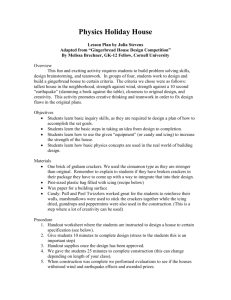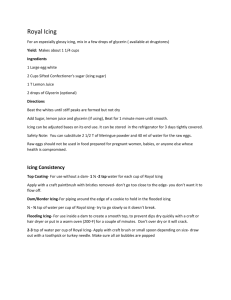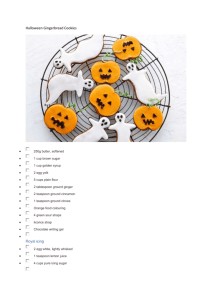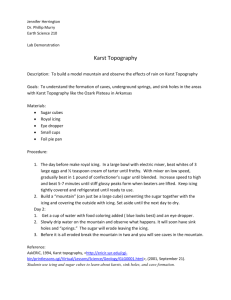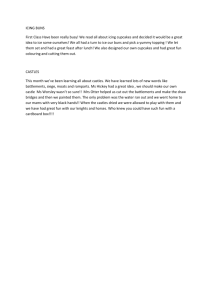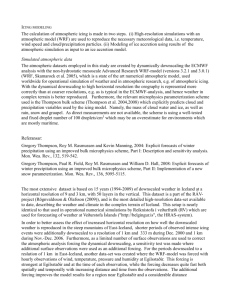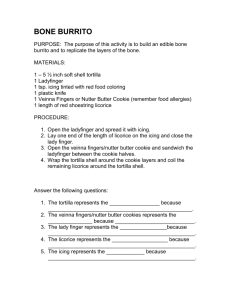ERAD 2012
advertisement
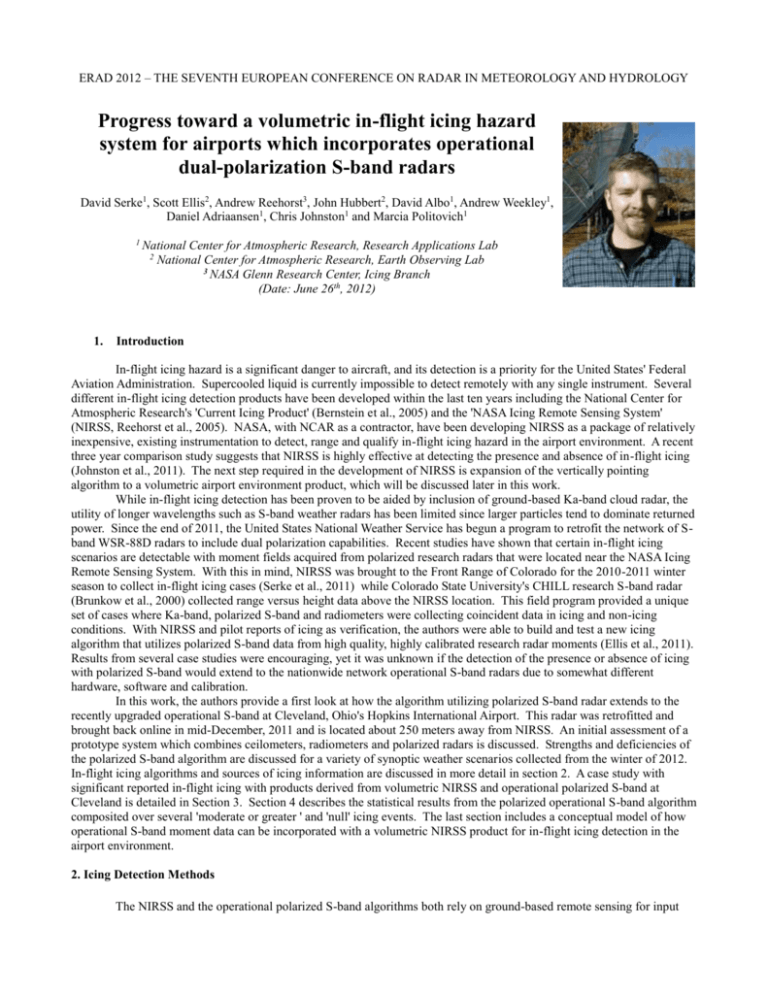
ERAD 2012 – THE SEVENTH EUROPEAN CONFERENCE ON RADAR IN METEOROLOGY AND HYDROLOGY Progress toward a volumetric in-flight icing hazard system for airports which incorporates operational dual-polarization S-band radars David Serke1, Scott Ellis2, Andrew Reehorst3, John Hubbert2, David Albo1, Andrew Weekley1, Daniel Adriaansen1, Chris Johnston1 and Marcia Politovich1 1 1. National Center for Atmospheric Research, Research Applications Lab 2 National Center for Atmospheric Research, Earth Observing Lab 3 NASA Glenn Research Center, Icing Branch (Date: June 26th, 2012) Introduction In-flight icing hazard is a significant danger to aircraft, and its detection is a priority for the United States' Federal Aviation Administration. Supercooled liquid is currently impossible to detect remotely with any single instrument. Several different in-flight icing detection products have been developed within the last ten years including the National Center for Atmospheric Research's 'Current Icing Product' (Bernstein et al., 2005) and the 'NASA Icing Remote Sensing System' (NIRSS, Reehorst et al., 2005). NASA, with NCAR as a contractor, have been developing NIRSS as a package of relatively inexpensive, existing instrumentation to detect, range and qualify in-flight icing hazard in the airport environment. A recent three year comparison study suggests that NIRSS is highly effective at detecting the presence and absence of in-flight icing (Johnston et al., 2011). The next step required in the development of NIRSS is expansion of the vertically pointing algorithm to a volumetric airport environment product, which will be discussed later in this work. While in-flight icing detection has been proven to be aided by inclusion of ground-based Ka-band cloud radar, the utility of longer wavelengths such as S-band weather radars has been limited since larger particles tend to dominate returned power. Since the end of 2011, the United States National Weather Service has begun a program to retrofit the network of Sband WSR-88D radars to include dual polarization capabilities. Recent studies have shown that certain in-flight icing scenarios are detectable with moment fields acquired from polarized research radars that were located near the NASA Icing Remote Sensing System. With this in mind, NIRSS was brought to the Front Range of Colorado for the 2010-2011 winter season to collect in-flight icing cases (Serke et al., 2011) while Colorado State University's CHILL research S-band radar (Brunkow et al., 2000) collected range versus height data above the NIRSS location. This field program provided a unique set of cases where Ka-band, polarized S-band and radiometers were collecting coincident data in icing and non-icing conditions. With NIRSS and pilot reports of icing as verification, the authors were able to build and test a new icing algorithm that utilizes polarized S-band data from high quality, highly calibrated research radar moments (Ellis et al., 2011). Results from several case studies were encouraging, yet it was unknown if the detection of the presence or absence of icing with polarized S-band would extend to the nationwide network operational S-band radars due to somewhat different hardware, software and calibration. In this work, the authors provide a first look at how the algorithm utilizing polarized S-band radar extends to the recently upgraded operational S-band at Cleveland, Ohio's Hopkins International Airport. This radar was retrofitted and brought back online in mid-December, 2011 and is located about 250 meters away from NIRSS. An initial assessment of a prototype system which combines ceilometers, radiometers and polarized radars is discussed. Strengths and deficiencies of the polarized S-band algorithm are discussed for a variety of synoptic weather scenarios collected from the winter of 2012. In-flight icing algorithms and sources of icing information are discussed in more detail in section 2. A case study with significant reported in-flight icing with products derived from volumetric NIRSS and operational polarized S-band at Cleveland is detailed in Section 3. Section 4 describes the statistical results from the polarized operational S-band algorithm composited over several 'moderate or greater ' and 'null' icing events. The last section includes a conceptual model of how operational S-band moment data can be incorporated with a volumetric NIRSS product for in-flight icing detection in the airport environment. 2. Icing Detection Methods The NIRSS and the operational polarized S-band algorithms both rely on ground-based remote sensing for input for their respective in-flight icing algorithms. NIRSS consists of three vertically pointing instruments: a laser ceilometer for defining cloud base, a Ka-band radar for defining cloud tops and bases as well as mixed phase conditions via Doppler spectral analysis (Serke et al., 2012) and a multichannel microwave radiometer (Hogg et al., 1983). The radiometer's Kband brightness temperatures are used to derive cloud liquid and vapor amounts, and the V-band is used to derive an atmospheric temperature profile (Solheim et al., 1998) by using an inversion method on a database of 10,000 radiosondes from the location nearest the radiometer's location and then training a neural network. Input from these instruments is merged and fuzzy logic is used to create a qualitative in-flight icing hazard characterization of the atmospheric profile. Recently, the system's radiometer has been collecting at multiple orthogonal azimuths at 15 degrees elevation. These slant scans reduce the contamination due to precipitation, increase resolution at lower altitudes and allow for derivation of a volumetric icing product (as discussed in Section 5). The polarized S-band process is described in detail in Ellis et al., 2012 and will be described here only as a highlevel overview. Radar moments of reflectivity, differential reflectivity, specific differential phase shift and correlation coefficient are ingested and the freezing level height is determined. This height is used to help adjust the temperature sounding from the the Weather Research Forecast Rapid Refresh Model. The moments and adjusted sounding are inputs to a particle identification module (Vivekanandan et al., 1999), and particle types not associated with existing in supercooled conditions are masked out of further processing. The moment fields are then used to calculate interest in the existance of freezing drizzle (based on Ikeda et al., 2008) and interest in the existance of mixed phase supercooled liquid water (MSLW based on Plummer et al., 2010) with fuzzy logic. The resulting interest values are thresholded and combined to arrive at a final icing product which is scaled from 0.0 to 1.0, with 0.0 being 'no icing', 0.5 being 'maybe icing' and 0.7 to 1.0 being 'yes icing'. While this algorithm has shown promise, there are several known deficiencies with the method. In weather scenarios where only small, non-precipitating supercooled drop sizes exist, the S-band will detect nothing as the returned signal would be below the radar's signal-to-noise ratio. These scenarios, such as freezing fog, are not uncommom across the northern US in winter. Also, previous work by Hubbert et al. (2010, parts. 1 and 2) describe how non-zero mean canting angle of ice crystals cause biases in the differential reflectivity field due to cross-coupling. This occurs with the simultaneous transmitted horizontal and vertical power in the operational radars but not in the fast alternating system employed by research S-band radars. Another source of information on the presence and severity of in-flight icing are pilot reports, or PIREPs. When commercial airline pilots notice weather conditions of interest to the operations of their flight, they can choose to radio in a pilot report of the condition to ground control. Our research relies on the presence of these reports to alert us to icing conditions, but the time, location and icing severities are not taken as absolute. Rather, multiple reports in the same general vicinity at around the same time from multiple craft are used as a primary indicator of an event. 3. Case Study February 25th, 2012 On February 25th of 2012, several moderate PIREPs were reported within 100 km of Cleveland's Hopkins Airport between 5:00 and 23:00 UTC. Flow from the west north west behind a cold from brought cold air over an unfrozen Lake Erie, which provided airmass instability. As the moisture laden air came onshore, clouds and snowshowers developed over land due to lake-effect enhancement. Temperatures were subfreezing through the entire profile and light snow was reported throughout the day, tapering off to flurries by 21 UTC. Figure 1 shows the tilt-by-tilt in-flight icing detection results from the prototype polarized S-band radar algorithm, as discussed in Section 2. Blue colors correspond to an icing interest of 0.0, which means that none of the interest thresholds for mixed phase supercooled liquid water or freezing drizzle were exceeded at a given pixel. Green colored pixels correspond to an icing interest of 0.5, which means that at least some of the fields that go into the MSLW or freezing drizzle calculations were close to but not exceeding thresholds for 'yes icing'. Lastly, any icing value above 0.7 is considered to be in the 'yes icing' category, since the MSLW and Freezing drizzle categories are designed to detect several different in-flight icing scenarios. Orange colored pixels correspond to interest fields for the freezing drizzle detection exceeding thresholds for icing detection. Maroon colored pixels correspond to interst fields for MSLW detection exceeding thresholds for icing detection, and bright red pixels mean both MSLW and freezing drizzle criteria were met. In all cases studied to date, very few pixels are ever categorized as 'both', lending creedence to the assertion that these two detection algorithms are correctly sensing disparate scenarios. In this case, the polarized S-band radar product saw significant coverage of 'yes icing' within the radar volume that was temporally closest to the moderate icing PIREPs. In the next section, results from the radar product are composited over several such cases. NIRSS radiometer was collecting 15 degree elevation slant profiles at the same time shown in Figure 1 at 45, 135, 225 and 315 degrees azimuth. The mean southeastward facing radiometer ILW was 0.28 gm-2 and the mean northwest facing ILW was 0.05 gm-2, which corresponded well with the developing Lake Effect snow showers shown south and east of the radar and the 'yes icing' determined by the polarized S-band algorithm. The directional variation of radiometer ILW in this and other cases will be utilized to create a volumetric NIRSS icing product, as discussed further in Section 5. Figure 1. Operational polarized S-band in-flight icing hazard product from the 1.5 degree elevation tilt for KCLE radar on 25Feb, 2012 at 22:40 UTC. The x-y axes are in km from the KCLE radar and NIRSS. 4. Multiple icing case comparisons During the period from January through March of 2012, the icing hazard product was calculated from the KCLE radar for complete radar volumes that were temporally closest to PIREPS with 'moderate or greater' or 'null' in-flight icing severity categories. Results for individual cases were tabulated (Table 1) as the total number of radar pixels in icing 'yes', 'maybe' and 'no' per volume divided by total pixels in the volume that had returned power above the signal-to-noise level. Individual case icing category percentages were then averaged for all cases in each severity category. The table shows that for the four analyzed case dates with 'moderate or greater' reported PIREP icing severities, about 30% of the operational radar volume was scored as 'yes icing', over 50% of the volume was scored 'maybe icing' and about 20% was scored as 'no icing'. For the three analyzed case dates with 'null' reported PIREP icing severities, about 10% of the operational radar volume was scored as 'yes icing', almost 60% was scored as 'maybe icing' and over 30% scored as 'no icing'. In the 'moderate or greater' cases, the majority of the detected icing was from the SLW algorithm, but for the 'null' icing cases, the majority of the detected icing pixels were from the freezing drizzle algorithm. Much analysis and tuning is required to optimize this radar-based algorithm, but these preliminary results show promise for the operational polarized S-band algorithm to detect icing, and should be followed up with further case analysis during the next winter season. PIREP Icing Number Icing Warning Category Severity of Cases 'yes' 'maybe' 'no' 'MOD or greater' 4 29.8% 51.4% 18.8% 'NULL' 3 10.9% 57.9% 31.2% Table 1. Percent of operational polarized S-band in-flight icing hazard product radar volume categorized as 'yes','maybe' and 'no icing' at times when moderate or greater and null severity PIREPs. Cases were within 100km of Cleveland, Ohio from February through March, 2012. 5. Volumetric NIRSS/polarized S-band Icing Product Since the prototype NIRSS system is designed to provide an icing hazard in the airport environment, and most of the US's S-band weather radars are located near major airports, it is reasonable to provide a conceptual analysis of how the these two remote sensing systems could be merged. Figure 2 shows a flow chart of polarized S-band icing detection algorithm (blue, Ellis et al., 2012) and NIRSS (black, Reehorst et al., 2005) with red squares showing new processing modules that would be needed and red lines indicating where fields from one product stream could be brought in to enhance the another product stream. For the operational polarized S-band product, a new module would be needed to detect radial fluctuations in ZDR introduced by canted frozen particles (Hubbert et al., parts 1 and 2, 2010). Since freezing level is calculated earlier on in this algorithm (blue 'Sounding Adjust' box), the new module would calculate a moving average of ZDR at several different constant ranges above the height of the freezing layer (Red 'S-pol ZDR bias detect/correct' box). If a periodic variability was detected, the affected region of the tilt would be identified as likely being effected by ZDR biasing due to frozen particle canting and the radar product would not be able to be computed. For NIRSS, the issue is how to extend the current vertically pointing system to a volumetric system. Here, a new processing module called 'Cloud 3-D Interpolate' would take input on the vertical extent of clouds and interpolate those heights over the airport volume based on the 3-D S-band reflectivity field ingested from the nearest operational S-band radar. Also, the module that determines possible icing heights based on radiometer temperature profile thresholding could be enhanced by ingesting the model temperature profile that is required for the S-band icing hazard algorithm. In this manner, a 3-D measure of drop size and icing severity from NIRSS and an icing product based on polarized operational S-band radars would be available in near realtime. In the future, these products could be combined in ways that take advantage of the strengths and weaknesses of the specific remote sensing systems in icing scenarios such as homogeneous small drop SLW, mixed phase SLW, freezing drizzle and freezing rain originating from any number of cloud layers with very high temporal and spatial resolution. Figure 2. A conceptual flow chart of currently available icing products that encompass the airport environment. Operational polarized S-band icing fields (blue ovals), processing modules (blue squares), NIRSS fields (black ovals), NIRSS processing modules (black squares) and future required enhancements (red arrows and squares). 6. Conclusion In this work the authors showed that the concept of an in-flight icing hazard product derived from polarized S-band research radars could be extended to the USA's network of operational S-band radars that is currently being upgraded to dual-polarization. Cases from the winter of 2012 showed that when 'moderate or greater' PIREP in-flight icing severities were present, a significant portion of the radar volume was in the 'yes icing' category according to the polarized icing detection algorithm. Three case dates with 'null' PIREP icing resulted in a majority of the mean volumes categorized as 'no icing' or 'maybe icing'. These results bode well for the future development of the prototype algorithm. One major shortcoming of the technique is that supercooled liquid water can form and exist as small drops in very high number concentrations which are not detectable by the relatively longer wavelength S-band precipitation radars. At least in these cases, other ground-based remote sensors will be needed. Another significant caveat to this polarized S-band technique is related to biasing of the ZDR field in the presence of canted particles. No cases have been collected to date where this form of bias is known to exist. A new processing module was proposed for future work which could detect when this biasing was occurring and attempt to correct for it, or simply refuse to calculate the product under the circumstances. A way was proposed to extend the NIRSS icing products to cover the whole aircraft takeoff and landing space volumetricly which ingests the operational S-band reflectivity. Both the NIRSS and polarized S-band in-flight icing hazard products have been shown to provide potential for accurately detecting in-flight icing hazard from supercooled liquid. Combining the remotely sensed fields obtained from both products would make sense financially and scientifically, and this work is a first step towards showing that it is feasible. Acknowledgments This research is sponsored by the NASA Aviation Safety Program under the Atmospheric Environment Safety Technologies (AEST) project. The views expressed are those of the authors and do not necessarily represent the official policy or position of the NASA. This work was also sponsored by the Federal Aviation Administration under Air Force Contract No. FA8721-05-C-0002. Opinions, interpretations, conclusions, and recommendations are those of the authors and are not necessarily endorsed by the United States Government. References Bernstein, B.C., F. McDonough, M.K. Politovich, B.G. Brown, T.P. Ratvasky, D.R. Miller, C.A. Wolff and G. Cunning, 2005: Current Icing Potential: Algorithm Description and Comparison with Aircraft Observations. J. Appl. Meteor., 44, pp. 969-986. Brunkow, D., Bringi, V. N., Kennedy, P, Rutledge, S., Chandrasekar, V., Mueller, E. and Bowie, R., 2000: “A description of the CSU–CHILL National Radar Facility”, J. Atmos. Ocean. Tech, 17, Issue 12, pp. 1596-1608. Ellis, S.M., D.Serke, J. Hubbert, D. Albo, A. Weekley and M.K. Politovich, 2011: “In-flight icing detection using S-band dual-polarimetric weather radar data”, AMS 35th Conf. on Radar Meteorology, Pittsburgh, PA, 26-30 September. Available online. Ellis, S.M., D.Serke, J. Hubbert, D. Albo, A. Weekley and M.K. Politovich, 2012: “Towards the Detection of Aircraft Icing Conditions Using Operational Dual-polarimetric Radar”, 7th European Radar Conference on Radar in Meteorology and Hydrology, Toulouse, FR, 24-29 June, Available online. Hogg, D.C., F.O. Guiraud, J.B. Snider, M.T., Decker and E.R. Westwater, “A steerable dual-channel microwave radiometer for measurements of water vapor and liquid water in the troposphere”, 1983: J. Climate Appl. Meteor., 22, pp. 789806. Hubbert, J., Ellis, S., Dixon, M. and Meymaris, G., 2010: “Modelling, error analysis and evaluation of dual-polarization variables obtained from simultaneous horizontal and vertical polarization transmit radar. Part II: modelling and antenna errors”, J. Atmos. Ocean. Tech., 27, pp.1583-1597. Hubbert, J., Ellis, S., Dixon, M. and Meymaris, G., 2010: “Modelling, error analysis and evaluation of dual-polarization variables obtained from simultaneous horizontal and vertical polarization transmit radar. Part II: experimental data”, J. Atmos. Ocean. Tech., 27, pp.1599-1607. Ikeda, K., Rasmussen, R., Brandes, E. and McDonough, F., 2008: “Freezing drizzle detection with WSR-88D radars”, J.Appl. Meteor. Climatol, 48, pp. 41-60. Johnston, C., Serke, D., Adriaansen, D., Reehorst, A., Politovich, M. K., Wolff, C. and McDonough, F., 2011: “Comparison of in-situ, model and ground based in-flight icing severity”, AMS Preprint, Jan. 24-27, Seattle, WA. Plummer, D.M., S. Goeke, R.M. Rauber and L.DiGirolamo, 2010: “Discrimination of mixed-versus ice-phase clouds using dual-polarization radar with application to detection of aircraft icing regions”, J. Appl. Meteor. Clim., 49, pp. 920 – 935. Reehorst, A.L., Brinker, D.J., Ratvasky, T.P., 2005: “NASA Icing Remote Sensing System: comparisons from AIRS–II,” NASA/TM—2005-213592. Serke, D., J., Hubbert, S. Ellis, A. Reehorst, P. Kennedy, D. Albo, A. Weekley and M. Politovich, 2011: “The winter 2010 FRONT/NIRSS in-flight icing detection field campaign”, AMS 35th Conf. on Radar Meteorology, Pittsburgh, PA, 26-30 September, Available online. Serke, D., Reehorst, A., and Politovich, M., 2012: “Using Ka-band Doppler fall velocity spectra to enhance NASA's Icing Remote Sensing System”, AMS Annual Conference, New Orleans, LA, 23-26 January, Available online. Solheim, F., Godwin, J., Westwater, E., Han, Y., Keihm, S., Marsh, K., and Ware, R., 1998: “Radiometric profiling of temperature, water vapor and cloud liquid water using various inversion methods”, Radio Science, 33, pp. 393-404. Vivekanandan, J., S.M. Ellis, R. Oye, D. S. Zrnic, A. V. Ryzhkov and J. Straka, 1999: “Cloud Microphysics Retrieval Using S-band Dual-Polarization Radar Measurements”, Bull. Amer. Meteor. Soc., 80, pp. 381-388.
